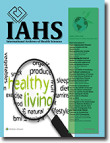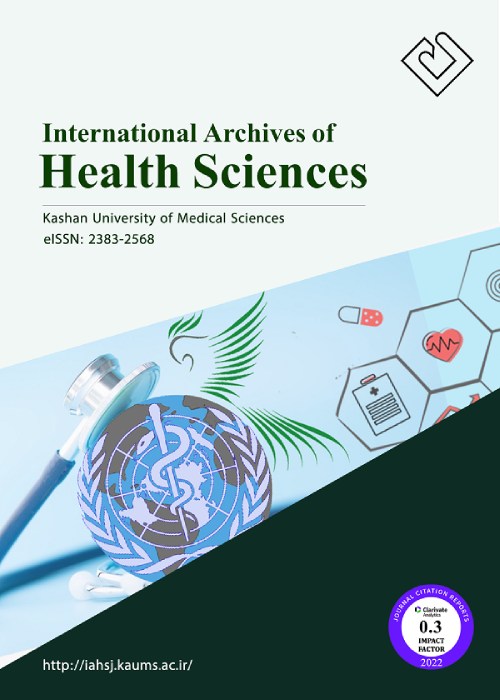فهرست مطالب

International Archives of Health Sciences
Volume:9 Issue: 4, Oct-Dec 2022
- تاریخ انتشار: 1401/09/14
- تعداد عناوین: 5
-
-
Pages 135-139Aims
In the backdrop of the huge and increasing burden of noncommunicable diseases (NCD) and unaddressed needs among the marginalized population, the study was conducted for risk assessment of NCD among commercial sex workers (CSWs) and to find out the detrimental effects of its associates.
Materials and MethodsA descriptive cross‑sectional study was conducted for 6 months (July–December 2021) among 440 Kolkata‑based CSWs, females and males, and intermediaries attending clinics run by the nongovernment organization providing outpatient department‑based services inside the area. With systematic random sampling, every 3rd patient was interviewed with pretested questionnaire comprising sociodemographics, Community‑Based Assessment Checklist for risk assessment of NCDs, and anthropometric measurement was done. The proportion was done for prevalence estimation, with SPSS Amos 26.0, structural equation modeling was done for testing the relation between high Community‑Based Assessment Checklist score and risk factors.
ResultsMajority 411 (93.4%) of the study participants were female sex workers and 14 were men having sex with men (MSMs). Age of the female participants was 39.08 ± 5.02 years. More than two‑third are smokers, and more than one‑third are alcoholics on regular basis. For NCDs, a score ≥4 was found among 302 (68.6%) of participants, and a significant association (P < 0.05) was found with tobacco use, alcohol consumption, higher body mass index, and physical inactivity. Structural equation also shows a positive relationship with NCD risk factors.
ConclusionCSWs in Kolkata have a high prevalence of NCD risk with a significant association of lifestyle factors. More intensive screening and regular treatment are needed to lower premature mortality and morbidity among them.
Keywords: Female sex workers, lifestyle factors, noncommunicable diseases, risk assessment, structural equation model -
Pages 140-144Aim
The present study aimed to determine the level of mothers’ comfort in sexual discourse (MCSD) with adolescent girls and related factors.
Materials and MethodsThis cross‑sectional study was conducted with cluster sampling (and then simple random sampling in the clusters) from 10 comprehensive urban health centers in Kashan in the winter of 2022 with participation of 384 mothers. Data were collected through questionnaires: “demographic and personal characteristics,” “MCSD,” and “mother’s interest in sexual discourse.” Using SPSS version 16, univariate analysis was performed using indices of dispersion and central tendency, Pearson’s correlation coefficient test, and ANOVA, and in the second step, all the variables with P < 0.2 in the univariate analysis were entered into the multiple linear regression model.
ResultsThe mean of MCSD was 37.04 ± 15.16 (on a scale of 13–78). Univariate analysis showed that MCSD has a significant relationship with several factors, but in the multivariate linear regression analysis, the simultaneous presence of two factors of mothers’ interest to sexual discourse with girl (the most important factor) and the curiosity of teenagers in obtaining sexual information from their mothers were reported significant in the model and the two mentioned factors explained 43.3% of the variance.
ConclusionIn mother–daughter sexual discourse, the level of interest and positive attitude of mothers and the curiosity of teenagers in obtaining sexual information from mothers are the two important factors of MCSD. Therefore, these factors should be taken into account in planning to keep and improve the health of adolescents.
Keywords: Adolescent, Iran, parent–child sexual communication, sexual, reproductive health, teenage girl -
Pages 145-151Aim
To find out variation in hospital attendance and admission for various infectious diseases (IDs) during the national lockdown as compared to prelockdown era.
Materials and MethodsThis observational descriptive cross‑sectional study was conducted at a state‑level ID hospital in West Bengal. Data related to the turnout of ID patients at the hospital outpatient department and indoor admission during the lockdown and unlock phases of 2020 were collected by review of hospital records and compared with the pre‑COVID period of 2019. Collected data were entered into an MS Excel sheet, and analysis was performed by SPSS 20.0.
ResultsSince April 2020, inpatient and outpatient turnout has gone far below the similar months of 2019. Outpatient consultation, indoor admission, anti‑rabies clinic attendance, and childhood immunization against vaccine‑preventable diseases had decreased significantly by 66.9%, 84.3%, 87%, and 85.2%, respectively, during lockdown (April–June 2020) compared to January–March 2020. Dramatic reduction noticed in hospital admission of diarrhea (93%), measles (96.5%), chicken pox (99.2%), acute respiratory illness (93.9%), diphtheria (66.7%), rabies (66.6%), and typhoid (98.2%) patients; while no cases of tetanus, swine flu, meningococcal meningitis, and mumps were admitted during lockdown period.
ConclusionIt is evidenced that measures put in place by the government to curb COVID‑19 spread disrupted other ID patient attendance at hospitals. Stigma and fear of contracting COVID‑19 during hospital visits and unavailability of transport due to lockdown could be the main reason for reduced attendance.
Keywords: COVID‑19, infectious diseases, lockdown, outpatient department attendance, pandemic -
Pages 152-157Aims
The purpose of the study was to examine the intention of the health ambassadors to receive the COVID‑19 vaccine, and investigate predictors of intention using the theory of planned behavior (TPB) and health belief model (HBM).
Materials and MethodsThis was a descriptive study conducted on 500 health ambassadors. Simple randomized sampling was applied to select the participants. We called the participants and asked them to fill out our 28‑item questionnaire. Univariate analyses were used to examine relationships between dependent and independent variables. We used the independent t‑test to measure the relationship between quantitatively independent variables and the Chi‑square or Fisher’s exact test to measure the relationship between qualitative independent variables. Finally, significant independent variables were entered into a hierarchical logistic regression model and the results were interpreted.
ResultsOverall, 44.8% (224) of participants reported that they have the intention to receive the COVID‑19 vaccine. The significant demographic predictors include age, having a chronic disease, Having COVID‑19 in the last year, and perceived health status. According to the HBM, the dimensions of perceived susceptibility, perceived benefits, and cues to action. According to the TPB, the dimensions of the subject norm, perceived behavior control, and self‑efficacy were significant predictors of vaccination.
ConclusionAccording to the low rate of COVID‑19 vaccination, health educational programs together with encouraging/reinforcing programs may change perceived susceptibility, perceived benefits, perceived behavioral control, and intention. It is better to use various kinds of sources to implement the educational program.
Keywords: COVID‑19, COVID‑19 vaccines, health belief model, intention, predictors, theory of planned behavior, vaccination -
Pages 158-163Aims
This study aims to investigate the relationship between diabetes mellitus (DM) or hypertension and the distribution and severity of pulmonary involvement and short‑term clinical outcome in patients with coronavirus disease 2019 (COVID‑19) pneumonia.
Materials and MethodsIn this case–control study, a group of patients with DM and COVID‑19 pneumonia are compared to a group without DM. Demographic information, history of diabetes, hypertension, renal disease, tobacco use, laboratory data, current blood pressure, and chest computed tomography (CT) scan of all patients were extracted. The patients’ laboratory tests were performed on the same day that the chest CT scan was performed. The data were analyzed using appropriate statistical tests.
FindingsThe results show that gender, age, smoking, and history of kidney disease were not significantly associated with the history of diabetes and hypertension (P > 0.05). Furthermore, the history of diabetes and hypertension had no significant relationship with the distribution and severity of pulmonary involvement and short‑term clinical outcome (P > 0.05). However, among the laboratory findings, hemoglobin, hematocrit, and erythrocyte sedimentation rate were significantly associated with a history of diabetes and blood urea nitrogen values were associated with a history of hypertension (P < 0.05).
ConclusionBased on the findings of this study, it can be concluded that the history of diabetes and hypertension has no significant relationship with the distribution and severity of pulmonary involvement and short‑term clinical outcome.
Keywords: COVID‑19, diabetes mellitus, hypertension, pneumonia, pulmonary involvement, severity, short‑term clinical outcome


